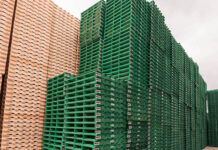
Lindum Packaging specialises in the use of transit packaging materials to maximise pallet stability and minimise environmental impact. Rick Sellars, business development manager, explains how assessing your pallet wrap can take you a step closer to your sustainability goals and win over eco-conscious customers.
THE idea of ‘problem plastics’ is not a new one, but for many it conjures images of single-use bottles, straws and six-pack rings floating in the ocean. Of the estimated five million tonnes of plastic used in the UK every year, nearly half is packaging, and more than 150,000 tonnes is pallet wrap.
Even to those in the industry it’s hard to imagine what that kind of volume looks like, (in case you’re wondering, 150,000 tonnes of used pallet wrap would take up the space of around 75,000 double decker buses). As a largely unseen part of the supply chain, the average consumer would have even more difficulty understanding just how much additional packaging is involved in their weekly shop.
While over-packaged individual products are a constant source of consumer complaints, over-wrapped pallets are rarely a hot topic of conversation. Nevertheless, consumers are becoming increasingly waste-conscious, and demanding more transparency about the overall footprint of the products they buy.
Additionally, for ecologically-savvy wholesale customers, plastic reduction initiatives can be an important selling point worth considering for all businesses. Giving them the knowledge that the products they buy have a lower environmental impact than your competitors could give you the edge.
By using excessive amounts of pallet wrap, the wrong materials, and often both, too many businesses are missing an opportunity to improve performance, save money and reduce packaging waste by as much as 50%. With a looming plastics tax and pressure from customers and consumers to do more for the environment, now is the time to ask if your business is making the most efficient use of pallet wrap.
So how can you turn this necessary plastic usage into a sustainability selling point?
Firstly, don’t forget used pallet wrap can be recycled, and many companies don’t realise that, as well as recycling being environmentally responsible, you can get good money for packaging waste. If your factory produces a lot of plastic waste, look at baling and recycling it. It’s an investment that pays off very quickly and is far better than sending waste to landfill.
Secondly, you may be thinking about switching to recycled pallet wrap, especially in light of the upcoming plastics tax. But be aware that most pallet wrap does not currently contain the 30% recycled plastic content stipulated to avoid paying the tax. It’s also expensive, and likely to become more so as demand increases ahead of the introduction of the plastics tax. However, we do have recycled content options available so you can make the switch to recycled content film, or optimise and reduce the amount of plastic used.
Analyse current practices and identify opportunities for improvement, then optimise your machinery and packaging materials as required. For example, many businesses are using 23-micron film where a 10-micron Carestretch NANO film would be more effective. Multi-layer nano materials can stretch up to 50% further without compromising strength or puncture resistance, and making the switch is usually a matter of making a simple adjustment to existing machinery.
It’s also worth assessing warehouse training, as inexperienced staff tend to compensate by using more pallet wrap than is needed, resulting in unnecessary waste.
Once changes to processes and materials have been made, it’s important to test packaging performance. Lindum can actually bring the test to you with our Mobile Pallet Stability Test Lab, which provides on-site real-time pallet stability testing. It tests four times quicker than traditional off-site methods, enabling more testing to be completed at a much lower cost per pallet.
Through such analysis and optimisation you can reduce plastic packaging waste and reduce your carbon footprint.
Switching pallet wrap may seem like a small change, but there are long term gains to be had for both the bottom line of businesses, the environment, your brand and corporate image.












